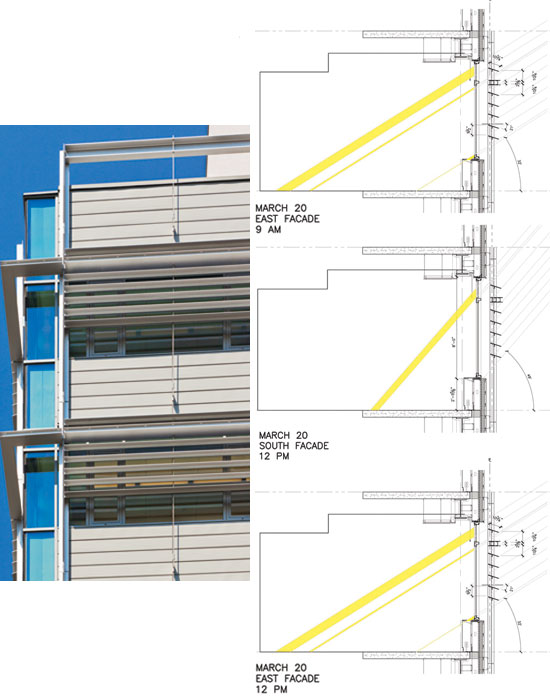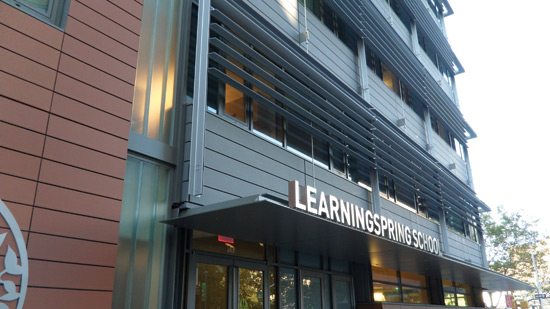More Than One Way to Skin a Building
Curtain Wall System–Filtered Light
Nowhere was this rationale of minimizing stimulus more conspicuous than in the design of the cladding enclosure system. “The building facade allows nice light in, but you feel there's an internal focus to rooms” says Mueller. “It's not about views, it's about mitigating light, eliminating glare, and making an environment that's comfortable so students can focus internally.”
PBDW began designing the facade as a window wall system with framed spandrel panels, thinking that it would be less expensive to construct than curtain wall. However, an integrated curtain wall system represented a better option during the construction and for the lifetime of the building. “We all felt that utilizing a curtain wall assembly would ensure a more reliable wall in the long run” says Mueller. “When you transition between different wall assemblies, it creates more opportunities for leaks and defects. Building the wall as essentially one type of assembly lessened this risk and still enabled us to create the expression we wanted.” This solution lent itself to improved construction, better coordination, and more control over the finished product as the sequencing involved only one primary trade. In the end, while the curtain wall was more expensive, the client and the design team felt that the upfront expense would minimize maintenance costs in the future, providing a long-term return on investment. The architects developed a scheme using zinc spandrel panels, operable windows, and aluminum louver solar shades, all designed to make the interiors feel both well-lit and sheltered.
 |
The louvers on the south side of the building were carefully studied and designed to create the desired shading and limit the amount of daylight entering the interior spaces. Photo by Frederick Charles, courtesy of the Ornamental Metal Institute of New York; sun diagram courtesy of Platt Byard Dovell White |
Structural Coordination
This curtain wall system is not unitized, but stick-built on site with aluminum mullions attached to building anchors. These anchors handle gravity loads on every other floor, while on the intervening floors clips that only manage wind loads are used. The operable windows are structurally glazed to the framing and consist of insulated glass units with ¼-inch inner lites, ½-inch gaps, and ¼-inch outer lites with low-e coatings on the #2 surface. The 1-millimeter quartz-zinc spandrels are a rainscreen system with an 18-gauge galvanized steel back panel, insulation, and vapor barrier, an air space, and then the exterior cladding. The back panel is glazed into the curtain wall pockets at the spandrel areas. Then vertical aluminum girts fasten to flanges on the back pane and the zinc panel attaches to these vertical girts. The exposed zinc panels are interlocking with concealed fasteners and feature cutouts allowing the supports for the aluminum sunshade system to penetrate through and be welded directly to the steel substructure. The sunshades, which are built from 5/16-inch-thick aluminum plates, span the 18- to 20-foot column bays. They hang from their own dedicated support system, which delivers all loads back to the main building structure rather than the curtain wall assembly. The span proved to be a bit extreme for the aluminum plates, which deflected from their own weight, raising concerns about how the louvers would react to wind loads. In response, the designers placed stainless steel tension rods running vertically through the sunshade system at the midpoint of the spans, holding them rigid in the face of wind and gravity. The rods are fabricated from solid ¾-inch-diameter 316 Grade stock. This primary wall assembly is accented by terra cotta rain screen details at the building's corners, as well as a channel glass feature that bookends the corners.
 |
The Learning Spring School uses the curtain wall to shade and filter light in spaces where autistic children are being educated. Photo by Fredrick Charles, courtesy of the Ornamental Metal Institute of New York |
Environmental Benefits
In addition to its well-designed appearance from the outside, and calming effects on the inside, the cladding design had an environmental payoff. The building's corner site at Second Avenue and 20th Street faces southwest, putting it right in the line of fire of New York's most punishing daylight. The 's aluminum sunshades, low-e coated insulated glass units, and zinc rainscreen spandrels all help to cut solar gain significantly. Along with the building's other environmentally friendly features, such as operable windows for natural ventilation, low-flow fixtures for water savings, and high-efficiency equipment for energy savings, the project received LEED for Schools Gold Certification in August of 2011.









